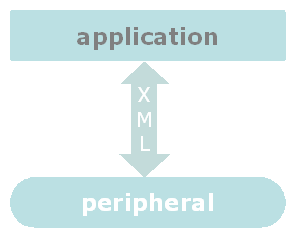|
|
Xpeak is not an acronym and its very name is indicative of its main objective: to speak by using Xml.
Xpeak is basically a series of specifications designed to standardise access to devices with a view to being able to use them from any type of application, whatever the programming language and operating system used. It must be taken into account that access to devices is one of the main obstacles when developing platform independent applications. The main objective of Xpeak is to allow access to the devices in an independent manner without being bound to any concrete language. For this reason, applications and devices communicate through XML. One of the other aims is to facilitate the migration between platforms given that it is possible to use the same access to devices via different languages simultaneously. As such, Xpeak architecture allows devices to be shared between different workstations. Not only can these workstations have different operating systems installed but can also be completely different applications, with different programming languages. Xpeak has not endeavoured to reinvent the wheel and takes reference from current market standards such as CEN/XFS, J/XFS and JavaPOS. Taking into account that a device does not cease to be an element which receives information (commands), processes it and sends an answer, the most appropriate way to communicate with it would be a standard message format and not a programming language (C, C++ or Java). This is one of the reasons for the creation of Xpeak. The communication between application and devices is asynchronous, using events. Although Xpeak defines the commands, answers and events of the communication with the devices, the channel used will depend on each implementation which could be, for example, directly with sockets or equally through WebServices, SOAP, etc. In summary, Xpeak takes responsibility for saying 'what to do' but not 'how to do it'. This guarantees not only the independence of the applications with the different models of devices but also the evolution and adaptation to new market requirements as they arise in the future. Xpeak also allows Plug&Play devices, which means that the peripheral firmware is capable of interpreting Xpeak commands without the necessity for any additional software on the workstation. These types of devices are known as Native Xpeak Devices. |


